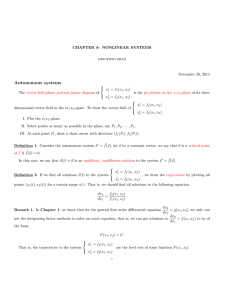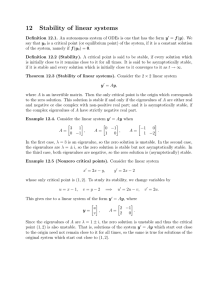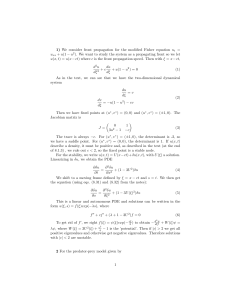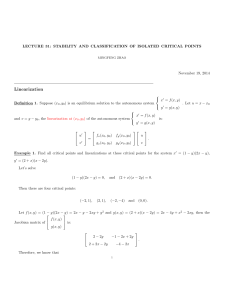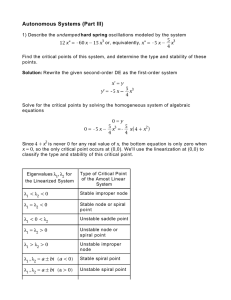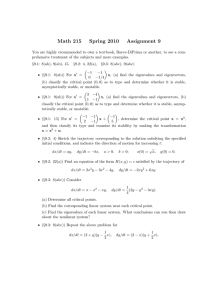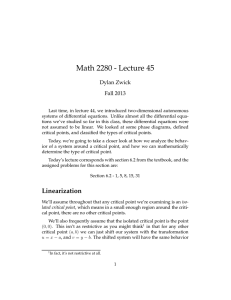Stability and classification of isolated critical points
advertisement
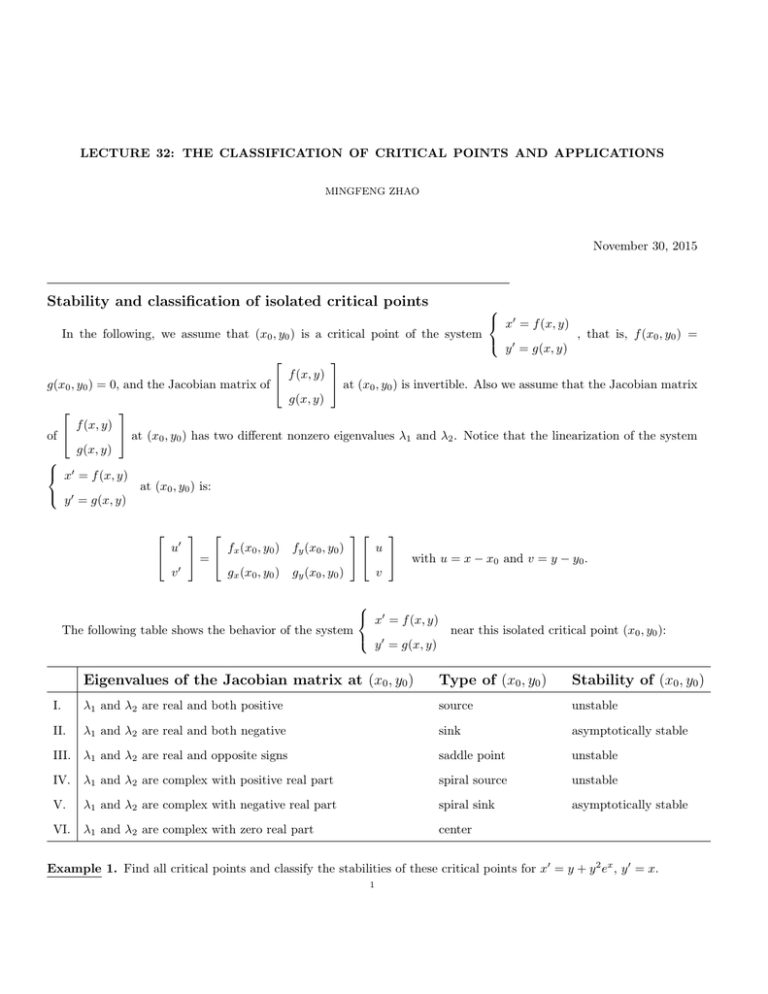
LECTURE 32: THE CLASSIFICATION OF CRITICAL POINTS AND APPLICATIONS MINGFENG ZHAO November 30, 2015 Stability and classification of isolated critical points x0 = f (x, y) In the following, we assume that (x0 , y0 ) is a critical point of the system , that is, f (x0 , y0 ) = y 0 = g(x, y) f (x, y) at (x0 , y0 ) is invertible. Also we assume that the Jacobian matrix g(x0 , y0 ) = 0, and the Jacobian matrix of g(x, y) f (x, y) at (x0 , y0 ) has two different nonzero eigenvalues λ1 and λ2 . Notice that the linearization of the system of g(x, y) x0 = f (x, y) at (x0 , y0 ) is: y 0 = g(x, y) u0 v0 = fx (x0 , y0 ) fy (x0 , y0 ) u gx (x0 , y0 ) gy (x0 , y0 ) with u = x − x0 and v = y − y0 . v x0 = f (x, y) The following table shows the behavior of the system near this isolated critical point (x0 , y0 ): y 0 = g(x, y) Eigenvalues of the Jacobian matrix at (x0 , y0 ) Type of (x0 , y0 ) Stability of (x0 , y0 ) I. λ1 and λ2 are real and both positive source unstable II. λ1 and λ2 are real and both negative sink asymptotically stable III. λ1 and λ2 are real and opposite signs saddle point unstable IV. λ1 and λ2 are complex with positive real part spiral source unstable V. λ1 and λ2 are complex with negative real part spiral sink asymptotically stable VI. λ1 and λ2 are complex with zero real part center Example 1. Find all critical points and classify the stabilities of these critical points for x0 = y + y 2 ex , y 0 = x. 1 2 MINGFENG ZHAO Let’s solve y + y 2 ex = 0 and x = 0, then (x, y) = (0, 0), and (x, y) = (0, −1). That is, all critical points of the system x0 = y + y 2 ex , y 0 = x are: (0, 0) and (0, −1) . Let f (x, y) = y + y 2 ex and g(x, y) = x, then Jacobian matrix of f (x, y) is g(x, y) fx (x, y) fy (x, y) gx (x, y) = gy (x, y) y 2 ex 1 + 2yex 1 0 . Therefore, we know that I. At (0, 0) the linearization is u0 v0 = 0 1 1 0 u with u = x and v = y. Notice that v invertible, then the system is almost linear at (0, 0) . Since the eigenvalues of 0 1 1 0 0 1 1 0 is are λ1 = −1 and λ2 = 1, then (0, 0) is an unstable critical point of the system, solutions behaves like a saddle point near (0, 0). u0 1 −1 u 1 −1 = with u = x and v = y + 1. Notice that is II. at (0, −1) the linearization is 0 v 1 0 v 1 0 √ 1 −1 1 3 and invertible, then the system is almost linear at (0, −1) . Since the eigenvalues of are λ1 = +i 2 2 1 0 √ 1 3 λ2 = − i , then (0, −1) is an unstable critical point of the system, solutions behaves like a spiral source 2 2 near (0, 0). Figure 1. Phase portrait with some trajectories of x0 = y + y 2 ex , y 0 = x LECTURE 32: THE CLASSIFICATION OF CRITICAL POINTS AND APPLICATIONS 3 The trouble with centers Recall, a linear system with a center meant that trajectories traveled in closed elliptical orbits in some direction around the critical point. It would not be an asymptotically stable critical point, as the trajectories would never approach the critical point, but at least if you start sufficiently close to the critical point, you will stay close to the critical point. The trouble with a center in a nonlinear system is that whether the trajectory goes towards or away from the critical point is governed by the sign of the real part of the eigenvalues of the Jacobian. Since this real part is zero at the critical point itself, it can have either sign nearby, meaning the trajectory could be pulled towards or away from the critical point. Example 2. Consider the system x0 = y, y 0 = −x + y 3 . It’s easy to see that (0, 0) is the only critical point. Let f (x, y) is f (x, y) = y and g(x, y) = −x + y 3 , then the Jacobian matrix of g(x, y) fx (x, y) fy (x, y) gx (x, y) So at (0, 0), the Jacobian matrix is 0 1 −1 0 gy (x, y) = 0 1 −1 3y 2 . which has eigenvalues ±i, that is, the linearization at (0, 0) has a center. p 3 2 4 − 9y 4 On the other hand, the eigenvalues of the Jacobian matrix at any point (x, y) are λ1,2 = y ± i . For any 2 2 point where y 6= 0, the eigenvalues have a positive real part, which will pull the trajectory away from the origin. Figure 2. An unstable critical point (spiral source) at the origin for x0 = y, y 0 = −x + y 3 4 MINGFENG ZHAO Conservative equations Definition 1. An equation of the form x00 + f (x) = 0 is called a conservative equation. Let y = x0 , then we have the system: x0 = y, and y 0 = −f (x). Then the trajectories will satisfy dy f (x) =− . dx y Solve the above equation, we get 1 2 y + 2 Z f (x) dx = C, which is called the Hamiltonian or energy of the system. p y 0 1 is which has eigenvalues λ1,2 = ± −f 0 (x). It’s easy to see that the Jacobian matrix of −f (x) −f 0 (x) 0 Therefore, there are only two possibilities for critical points, either an unstable saddle point, or a stable center; but never any asymptotically stable points for the system x0 = y, y 0 = −f (x). Example 3. Find the trajectories for the equation x00 + x − x2 = 0. Let y = x0 , then x0 = y, So we get y 0 = x00 = x2 − x. dy x2 − x = , so the trajectories satisfy dx y 1 1 1 2 y = x3 − x2 + C . 2 3 2 Figure 3. Phase portrait with some trajectories of x0 = y, y 0 = −x + x2 LECTURE 32: THE CLASSIFICATION OF CRITICAL POINTS AND APPLICATIONS 5 x0 = y Remark 1. For the system , it’s easy to see that there are two critical points: (0, 0) and (1, 0). Let y 0 = −x + x2 f (x, y) is: f (x, y) = y and g(x, y) = −x + x2 , then the Jacobian matrix of g(x, y) fx (x, y) fy (x, y) gx (x, y) u0 v0 = Notice that eigenvalues of 0 1 −1 0 0 1 −1 0 u0 v0 = Notice that eigenvalues of 1 0 0 u . , with u = x and v = y. v is: u 1 −1 + 2x 0 are λ1,2 = ±i, so (0, 0) is a center . 1 1 1 0 0 = 0 is: x0 = y • At (1, 0) the linearization of y 0 = −x + x2 gy (x, y) x0 = y • At (0, 0) the linearization of y 0 = −x + x2 , with u = x − 1 and y = y. v are λ1,2 = ±1, so (1, 0) is a unstable saddle point . Problems you can do: Lebl’s Book [2]: All Exercises on Page 305, Page 306, Page 312, Page 313, Page 321 and Page 322. Braun’s Book [1]: All exercises on Page 393 and Page 398. Read all materials in Section 4.3 and Section 4.4. References [1] Martin Braun. Differential Equations and Their Applications: An Introduction to Applied Mathematics. Springer, 1992. [2] Jiri Lebl. Notes on Diffy Qs: Differential Equations for Engineers. Createspace, 2014. Department of Mathematics, The University of British Columbia, Room 121, 1984 Mathematics Road, Vancouver, B.C. Canada V6T 1Z2 E-mail address: mingfeng@math.ubc.ca



